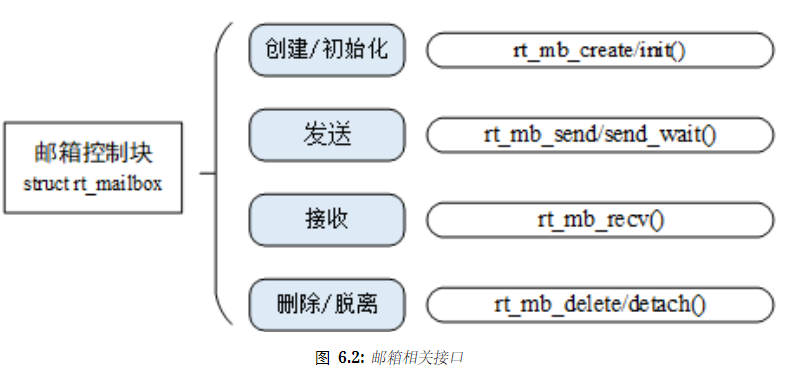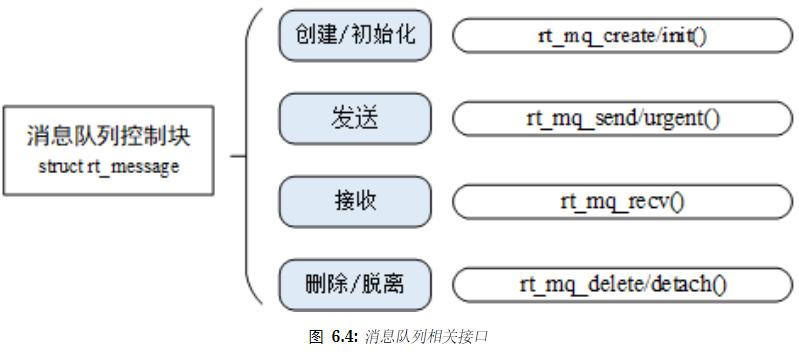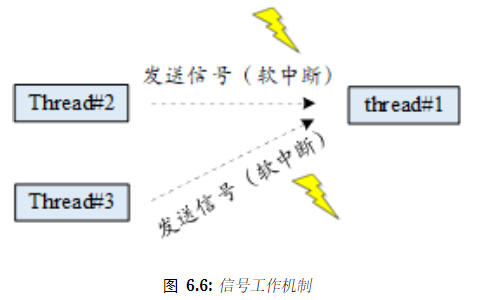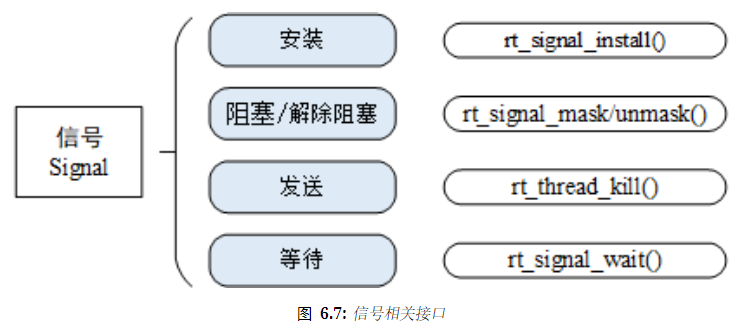layout: post
title: “RT-Thread线程间通信”
date: 2024-2-5 15:39:08 +0800
tags: RT-Thread
线程间通信
这一篇是实际使用, 代码分析看后面的文章
一般可以使用全局变量以及线程间同步进行实现
RT-Thread也提供了一部分的通信机制
邮箱
一个线程发送, 另外的线程接受信息, 进行处理
使用邮箱的时候每一次只能发送一个四字节的数据(32位处理器),特点是开销比较低,效率较高
可以发送一个地址从而达到发送多个数据的目的
非阻塞方式的邮件发送过程能够安全的应用于中断服务中, 发送以及接受信息的时候可以使用阻塞的模式
邮箱有一个缓存区, 使用rt_mailbox_t进行控制
实际使用

创建(初始化)
/** 动态的方式创建* This function will create a mailbox object from system resource** @param name the name of mailbox 记录一个名字* @param size the size of mailbox 记录一下缓存区的大小* @param flag the flag of mailbox 一个标志位** @return the created mailbox, RT_NULL on error happen*/
rt_mailbox_t rt_mb_create(const char *name, rt_size_t size, rt_uint8_t flag)/** 静态的方式创建* This function will initialize a mailbox and put it under control of resource* management.** @param mb the mailbox object 邮箱的句柄* @param name the name of mailbox 名字* @param msgpool the begin address of buffer to save received mail 缓存区的地址* @param size the size of mailbox 缓冲区大小* @param flag the flag of mailbox 标志** @return the operation status, RT_EOK on successful*/
rt_err_t rt_mb_init(rt_mailbox_t mb,const char *name,void *msgpool,rt_size_t size,rt_uint8_t flag)
这一个标志位可以为RT_IPC_FLAG_FIFO或RT_IPC_FLAG_PRIO, 设置的是挂起任务被释放的时候是按照进入的顺序先进入的先出去还是优先级比较高的先出去
删除
/**动态* This function will delete a mailbox object and release the memory** @param mb the mailbox object** @return the error code*/
rt_err_t rt_mb_delete(rt_mailbox_t mb)
/**静态* This function will detach a mailbox from resource management** @param mb the mailbox object** @return the operation status, RT_EOK on successful*/
rt_err_t rt_mb_detach(rt_mailbox_t mb)
发送邮件
/*** This function will send a mail to mailbox object, if there are threads* suspended on mailbox object, it will be waked up. This function will return* immediately, if you want blocking send, use rt_mb_send_wait instead.** @param mb the mailbox object* @param value the mail 要发送的数据** @return the error code*/
rt_err_t rt_mb_send(rt_mailbox_t mb, rt_ubase_t value)
这是一个不等待的时钟发送函数
/*** This function will send a mail to mailbox object. If the mailbox is full,* current thread will be suspended until timeout.** @param mb the mailbox object* @param value the mail* @param timeout the waiting time 多了一个等待时间** @return the error code*/
rt_err_t rt_mb_send_wait(rt_mailbox_t mb,rt_ubase_t value,rt_int32_t timeout)
接收
/*** This function will receive a mail from mailbox object, if there is no mail* in mailbox object, the thread shall wait for a specified time.** @param mb the mailbox object* @param value the received mail will be saved in 给出一个存放收到的数据的位置* @param timeout the waiting time** @return the error code*/
rt_err_t rt_mb_recv(rt_mailbox_t mb, rt_ubase_t *value, rt_int32_t timeout)
使用技巧
可以使用一个这样的结构体, 每次发送这一个结构体的地址, 进行大于32字节的数据发送
struct msg
{uint32_t *data;uint32_t size;
}
消息队列
是邮箱的扩展, 没有4字节的限制
消息队列能够接收来自线程或中断服务例程中不固定长度的消息,并把消息缓存在自己的内存空间中。这些消息使用的是链表进行连接, 消息先进先出
这一个使用的拷贝的模式进行传输, 不建议直接发送大量数据(可以发送一个地址)
可以用于发送不定长的数据, 实际使用的时候可以使用消息队列发送消息, 使用邮箱表示接收到数据了

实际使用

创建
/**动态* This function will create a message queue object from system resource** @param name the name of message queue 名字* @param msg_size the size of message 每一个消息的大小(字节)* @param max_msgs the maximum number of message in queue 记录一下消息的最大的个数* @param flag the flag of message queue 一个标志** @return the created message queue, RT_NULL on error happen*/
rt_mq_t rt_mq_create(const char *name,rt_size_t msg_size,rt_size_t max_msgs,rt_uint8_t flag)
/**静态* This function will initialize a message queue and put it under control of* resource management.** @param mq the message object 对象的句柄* @param name the name of message queue* @param msgpool the beginning address of buffer to save messages 缓冲区的地址, 动态申请* 的时候这个的大小是 (一个数据的大小+sizeof(struct rt_mq_message)) * mq->max_msgs* @param msg_size the maximum size of message一个消息的大小* @param pool_size the size of buffer to save messages 缓冲区的大小* @param flag the flag of message queue** @return the operation status, RT_EOK on successful*/
rt_err_t rt_mq_init(rt_mq_t mq,const char *name,void *msgpool,rt_size_t msg_size,rt_size_t pool_size,rt_uint8_t flag)
这一个标志位可以为RT_IPC_FLAG_FIFO或RT_IPC_FLAG_PRIO, 设置的是挂起任务被释放的时候是按照进入的顺序先进入的先出去还是优先级比较高的先出去
删除
/**动态* This function will delete a message queue object and release the memory** @param mq the message queue object** @return the error code*/
rt_err_t rt_mq_delete(rt_mq_t mq)
/**静态* This function will detach a message queue object from resource management** @param mq the message queue object** @return the operation status, RT_EOK on successful*/
rt_err_t rt_mq_detach(rt_mq_t mq)
发送消息
/*** This function will send a message to message queue object, if there are* threads suspended on message queue object, it will be waked up.** @param mq the message queue object * @param buffer the message 发送的消息的地址* @param size the size of buffer 发送的数据的大小** @return the error code*/
rt_err_t rt_mq_send(rt_mq_t mq, const void *buffer, rt_size_t size)
不等待
/*** This function will send a message to message queue object. If the message queue is full,* current thread will be suspended until timeout.** @param mq the message queue object* @param buffer the message* @param size the size of buffer* @param timeout the waiting time** @return the error code*/
rt_err_t rt_mq_send_wait(rt_mq_t mq,const void *buffer,rt_size_t size,rt_int32_t timeout)
等待
/*** This function will send an urgent message to message queue object, which* means the message will be inserted to the head of message queue. If there* are threads suspended on message queue object, it will be waked up.** @param mq the message queue object* @param buffer the message* @param size the size of buffer** @return the error code*/
rt_err_t rt_mq_urgent(rt_mq_t mq, const void *buffer, rt_size_t size)
发送一个紧急的消息, 这一个消息会直接放到队首
接收
/*** This function will receive a message from message queue object, if there is* no message in message queue object, the thread shall wait for a specified* time.** @param mq the message queue object* @param buffer the received message will be saved in 接收到的数据* @param size the size of buffer* @param timeout the waiting time** @return the error code*/
rt_err_t rt_mq_recv(rt_mq_t mq,void *buffer,rt_size_t size,rt_int32_t timeout)
信号(软件中断信号)
**注: **信号这块应该是要在微内核里使用,如果你是用宏内核版本,不推荐使用信号功能。
POSIX标准定义了sigset_t类型来定义一个信号集, 实际是一个unsigned long类型的数据, 应用程序能够使用的信号为SIGUSR1(10)和SIGUSR2(12)
他的本质是一个软件中断
收到信号的线程实际的处理方法有三种
- 类似中断的处理程序,对于需要处理的信号,线程可以指定处理函数,由该函数来处理。
- 忽略某个信号,对该信号不做任何处理,就像未发生过一样。
- 对该信号的处理保留系统的默认值。

需要定义RT_USING_SIGNALS这一个宏
实际使用

安装信号
如果线程要处理某一信号,那么就要在线程中安装该信号。
主要用来确定信号值及线程针对该信号值的动作之间的映射关系,即线程将要处理哪个信号,该信号被传递给线程时,将执行何种操作。
rt_sighandler_t rt_signal_install(int signo, rt_sighandler_t handler)
(这一个函数是给现在的线程安装)
signo信号值(只有SIGUSR1和SIGUSR2是开放给用户使用的)
handler设置对信号值的处理方式, 这一个的实际的函数是void (*rt_sighandler_t)(int signo);
也可以使用SIG_IGN,忽略某个信号, SIG_DFL,系统会调用默认的处理函数_signal_default_handler()
返回安装信号前的handler值表示成功
阻塞(屏蔽)信号
该信号将不会递达给安装此信号的线程,也不会引发软中断处理。
void rt_signal_mask(int signo)
解除信号阻塞
void rt_signal_unmask(int signo)
发送信号
int rt_thread_kill(rt_thread_t tid, int sig)
tid: 接收信号的线程
sig: 信号值
等待信号
int rt_signal_wait(const rt_sigset_t *set, rt_siginfo_t *si, rt_int32_t timeout)
set: 指定等待的信号
si: 指向存储等到信号信息的指针
)


)

)








)



)
